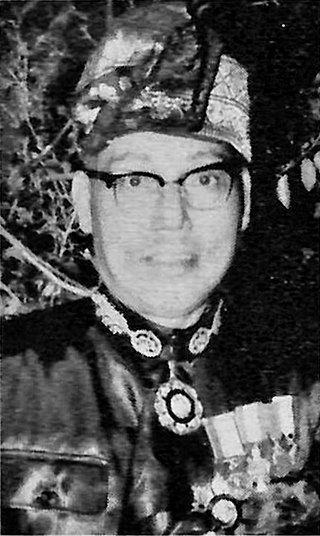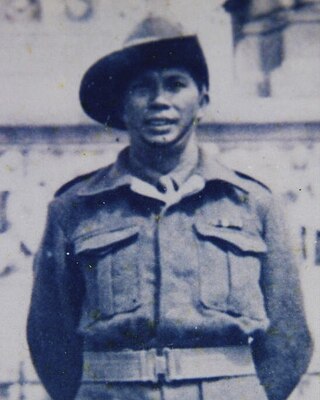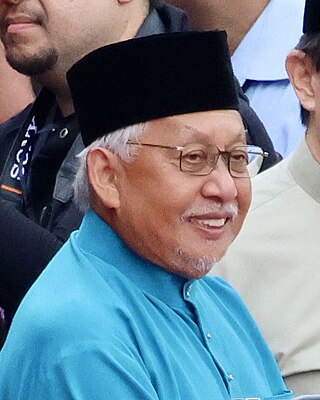Related Research Articles
Omar Ali Saifuddin I ibni Muhammad Alauddin, also known as Al-Marhum Makam Besar, was the 18th Sultan of Brunei and the second son of Sultan Muhammad Alauddin. He was regarded as one of the longest-serving sultans and was renowned for his wise leadership and just rule, merely following his father-in-law, Sultan Hussin Kamaluddin. In fact, he received helpful knowledge, counsel, and experience from his father-in-law when he was still alive during his reigning period.

Bendahara is an administrative position within classical Malay kingdoms comparable to a vizier before the intervention of European powers during the 19th century. A bendahara was appointed by a sultan and was a hereditary post. The bendahara and the sultan shared the same lineage.

Bolkiah ibni Sulaiman, also known for his title as Nakhoda Ragam, was the sixth Sultan of Brunei; reigning from 1485 until his death in 1524, he ascended the throne upon the abdication of his father, Sultan Sulaiman. His reign is known by Bruneians as "the Golden Age of Brunei".
Saiful Rijal ibni Abdul Kahar, also spelled Saiful Rehal and Saiful Rizal, was the eighth Sultan of Brunei and reigned from 1533 to 1581. He was succeeded by his eldest son Shah Berunai.
Sulaiman al-Qanuni ibni Sharif Ali, also known as Senior King and Adipati Agung, was the fifth Sultan of Brunei, according to Silsilah Raja-Raja Berunai. He succeeded his father in 1432 and ruled until his abdication in 1485, to allow his son Bolkiah to become Sultan.
Muhammad Hasan ibni Saiful Rijal Nurul Alam, also known as Marhum di Tanjung, was the tenth Sultan of Brunei from 1582 to 1598. Under him, the Bruneian Empire had apparently full control of the island of Borneo and Northern Philippines, including Sulu.

The Ministry of Religious Affairs (MORA or MoRA; Malay: Kementerian Hal Ehwal Ugama, KHEU) is a cabinet-level ministry in the government of Brunei which is responsible for the propagation of Islam and its upholding as the state religion, as well as oversees the Islamic religious education in the country. It is currently led by a minister and a deputy minister, whereby the incumbents are Badaruddin Othman and Pengiran Mohd Tashim Pengiran Hassan respectively. The ministry is headquartered in Bandar Seri Begawan.

The Royal Brunei Mausoleum is a Royal Mausoleum of Brunei located at Jalan Tutong, Bandar Seri Begawan, Brunei. The Mausoleum is the main resting place and burial ground for several Sultans of Brunei and members of the Royal Family. The Royal Mausoleum was opened during the reign of Sultan Omar 'Ali Saifuddin I who later became the first monarch to be buried in the Mausoleum when he died in 1795.

Pengiran Anak Mohamed Alam OBE was a nobleman and politician who became the fourth Speaker of the Brunei Legislative Council from 1971 until 1974 and Chief of Jabatan Adat Istiadat Negara from 1954 to 1981. He is the father of Pengiran Anak Saleha, the queen consort of Hassanal Bolkiah, the current Sultan of Brunei. He was also a maternal grandfather of Al-Muhtadee Billah, the Crown Prince.

Jame' Asr Hassanil Bolkiah Mosque, is a mosque in Kampong Kiarong of Bandar Seri Begawan, Brunei. It is named after Hassanal Bolkiah, the 29th and current Sultan of Brunei. It is one of the two state mosques, the other Omar Ali Saifuddien Mosque.

Pengiran Anak Besar was a member of the royal family as the wife of Pengiran Anak Mohammad Alam and the mother of Pengiran Anak Saleha, the queen consort of Hassanal Bolkiah, the 29th Sultan of Brunei.

The Kianggeh Dagang Muslim Cemetery, also known as the Residency Muslim Cemetery, is a Muslim burial ground located at Kianggeh in Bandar Seri Begawan, the capital of Brunei Darussalam. The cemetery was formerly a Royal burial ground which known as Bukit Tinggi Royal Mausoleum which served as resting place for past Sultans of Brunei. The first Sultan of Brunei buried here was Sultan Saiful Rijal, the 7th Sultan of Brunei who died in 1581.

Cermin Island is an islet at the mouth of Brunei River in the Mukim Kota Batu, Brunei-Muara District, Brunei. During the Brunei Civil War, a battle unfolded on the island and it's sometimes referred to as the Peperangan Pulau Cermin. A proposal for an 5 hectares protection status to be implemented on the island. The island is home to sundry vegetation and swamp forests.
Nasruddin ibni Besar Abdullah, sometimes spelled Nassaruddin and posthumously named Marhum di Kianggeh, was the self-proclaimed 16th Sultan of Brunei and the grandson of Sultan Abdul Jalilul Akbar. It was under his reign that the first gold coins or pitis were introduced, with the name Nasiruddin Malik al Zahir.

Pengiran Anak Hashim, also simply referred to as P. M. Hashim, was a Bruneian nobleman and politician who formerly held several high-ranking positions which included being a member of the Privy Council, Legislative Council, and the Islamic Religious Council.

Pengiran Mohammad bin Pengiran Abdul Rahman Piut MBE or commonly referred to by his title Pengiran Temenggong and nicknamed National Hero, was a Bruneian nobleman, teacher and politician who formerly held several high-ranking positions which included being a member of the State Council, Privy Council, and the Islamic Religious Council. Notably, he is one of the founding members of the Royal Brunei Yacht Club and the Chairman of the Brunei Boxing Association.

Dato Paduka Seri Setia Ustaz Haji Abdul Hamid bin Bakal was a Bruneian nobleman and Muslim scholar who held several high-ranking and important positions in the Government of Brunei.

Pengiran Muhammad Salleh (1890–1969) was a Bruneian nobleman and politician who formerly held several high-ranking positions which included being a member of the State Council, Privy Council, Legislative Council, and the Chief Kadi.

The Military of the Bruneian Sultanate was the land force of the Bruneian Sultanate from 1368 to 1888.

Pengiran Anak Idris is a Bruneian nobleman and member of the royal family who became the prince consort to Princess Amal Umi Kalthum Al-Islam in 1972, the daughter of Sultan Omar Ali Saifuddien III. He is the current Chief of Jabatan Adat Istiadat Negara, a member of the Privy Council of Brunei, and assistant chairman of Adat Istiadat Council, and Yayasan Sultan Haji Hassanal Bolkiah's board of governors.
References
- ↑ "Sejarah Sultan-Sultan Brunei" (PDF). Hmjubliemas.gov.bn. Retrieved 3 February 2018.
- ↑ Borneo Bulletin Brunei Yearbook. Brunei Press Sdn. Bhd. in collaboration with Integrated Information Pte. Limited. 2007. pp. E-89.
- 1 2 3 "Pusat Sejarah Brunei - Sultan - Sultan Brunei". www.history-centre.gov.bn. Retrieved 3 May 2023.
- 1 2 Awang.), Abdul Aziz bin Awang Juned (Pehin Tuan Imam Dato Paduka Seri Setia Haji (2008). Islam in Brunei: During the Reign of His Majesty Sultan Haji Hassanal Bolkiah Mu'izzaddin Waddaulah, Sultan and Yang Di-Pertuan of Brunei Darussalam. Brunei History Centre, Ministry of Culture, Youth and Sports. pp. XXXIII. ISBN 978-99917-34-55-2.
- ↑ Brunei (1974). Annual Report. Printed at the Brunei Press. p. 388.
- ↑ Thiessen, Tamara (2012). Borneo: Sabah, Brunei, Sarawak. Bradt Travel Guides. p. 133. ISBN 978-1-84162-390-0.
- ↑ Syed, Muzaffar Husain; Akhtar, Syed Saud; Usmani, B. D. (14 September 2011). Concise History of Islam. Vij Books India Pvt Ltd. p. 518. ISBN 978-93-82573-47-0.
- ↑ Brunei (1961). Annual Report on Brunei. Printed at the Brunei Press. p. 159.
- ↑ Hajah.), Saadiah binti Datu Derma Wijaya Haji Tamit (Datin (2012). Pembubaran perkahwinan dalam undang-undang keluarga Islam Brunei dan perbandingan dengan undang-undang keluarga Islam Malaysia (in Malay). Dewan Bahasa dan Pustaka Brunei, Kementerian Kebudayaan, Belia dan Sukan. p. 5. ISBN 978-99917-0-727-3.
